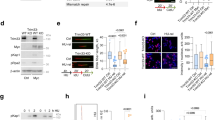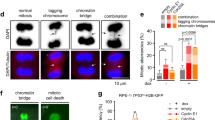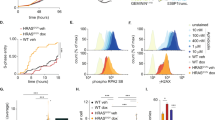Abstract
Although it is clear that p53 plays a pivotal role in G1/G2 checkpoints to conserve genomic integrity, its role in S phase checkpoint is less well understood. Recently, it has been reported that p53 is transcriptionally impaired even though it is stabilized during replication blockade. However, the mechanisms underlying this phenomenon are not known. In the present study, it has been shown that p53 accumulates and transactivates its target genes such as p21, gadd45 and bax in response to replication blockade in normal and cancer cells. Lack of transcriptional activation under similar conditions in cells lacking p53 shows that p53-target gene activation during replication blockade is indeed p53-dependent. Further, transactivation of p21 in response to replication blockade by hydroxyurea and aphidicolin is similar to that in response to ionizing radiation except that the latter is more immediate compared to the response to replication blockade. These findings suggest that impairment of transcriptionally active p53 in response to replication blockade is not a general phenomenon.
This is a preview of subscription content, access via your institution
Access options
Subscribe to this journal
Receive 50 print issues and online access
$259.00 per year
only $5.18 per issue
Buy this article
- Purchase on Springer Link
- Instant access to full article PDF
Prices may be subject to local taxes which are calculated during checkout




Similar content being viewed by others
References
Avantaggiati ML, Ogryzko V, Gardner K, Giordano A, Levine AS, Kelly K . 1997 Cell 89: 1175–1184
Brugarolas J, Chandrasekaran C, Gordon JI, Beach D, Jacks T, Hannon GJ . 1995 Nature (London) 377: 552–557
Bunz F, Dutriaux A, Lengauer C, Waldman T, Zhou S, Brown JP, Sedivy JM, Kinzler KW, Vogelstein B . 1998 Science 282: 1497–1501
Chan TA, Hwang PM, Hermeking H, Kinzler KW, Vogelstein B . 2000 Genes Dev. 14: 1584–1588
Chaudhry MA, Chodosh LA, Mckenna WG, Muschel RJ . 2002 Oncogene 21: 1934–1942
Das G, Hinkley CS, Herr W . 1995 Nature (London) 374: 657–660
Debbas M, White E . 1993 Genes Dev. 7: 546–554
Giaccia AJ, Kastan MB . 1998 Genes Dev. 12: 2973–2983
Gottifredi V, Sheieh S-Y, Taya Y, Prives C . 2001 Proc. Natl. Acad. Sci. USA 98: 1036–1041
Gu W, Shi X-L, Roeder R . 1997 Nature (London) 387: 819–823
Hermeking H, Lengauer C, Polyak K, He TC, Zhang L, Thiagalingam S, Kinzler KW, Vogelstein B . 1997 Mol. Cell 1: 3–11
Ji C, Marnett LJ, Pietenpol JA . 1997 Oncogene 15: 2749–2753
Karuppayil SM, Moran E, Das GM . 1998 J. Biol. Chem. 273: 17303–17306
Ko LJ, Prives C . 1996 Genes Dev. 10: 1054–1072
Levine AJ . 1997 Cell 88: 323–331
Lill NL, Grossman SR, Ginsberg D, DeCarpio J, Livingston DM . 1997 Nature (London) 387: 823–827
Linke SP, Clarkin KC, Di Leonardo A, Tsou A, Wahl GM . 1996 Genes Dev. 10: 934–947
Oren M . 1999 J. Biol. Chem. 274: 36031–36034
Prives C, Manley JL . 2001 Cell 107: 815–818
Ryan KM, Phillips AC, Vousden KH . 2001 Curr. Opin. Cell Biol. 13: 332–337
Scolnick DM, Chehab NH, Stavridi ES, Lien MC, Caruso L, Moran E, Berger SL, Halazonetis TD . 1997 Cancer Res. 57: 3693–3696
Takimoto R, El-Deiry WS . 2001 Proc. Natl. Acad. Sci. USA 98: 781–783
Taylor WR, Agarwal ML, Agarwal A, Stacey DW, Stark GR . 1999 Oncogene 18: 283–295
Tommasino M, Crawford L . 1995 Bioessays 17: 509–518
Vogelstein B, Lane D, Levine AJ . 2000 Nature (London) 408: 307–310
Wang XW, Zhan Q, Coursen JD, Khan MA, Kontny HU, Yu L, Hollander MC, O'Connor PM, Fornace Jr AJ, Harris CC . 1999 Proc. Natl. Acad. Sci. USA 96: 3706–3711
Wazer DE, Liu X, Chu Q, Gao Q, Band V . 1995 Proc. Natl. Acad. Sci. USA 92: 3687–3691
Wu X, Levine AJ . 1994 Proc. Natl. Acad. Sci. USA 91: 3602–3606
Zhou BB, Elledge SJ . 2000 Nature (London) 408: 433–439
Acknowledgements
We thank Mr Charles Thomas of Institutional Flow Cytometry Core Facility for the cell cycle analysis. We thank Drs Michael Brattain, Roswell Park Cancer Institute, Buffalo, NY, USA, Susan Conrad, Michigan State University, East Lansing, MI, USA, Martha Stampfer, Lawrence Berkeley National Laboratory, Berkeley, CA, USA, for kindly providing the RKO and HCT116 cells, MCF7 cells, and HMEC184AA3 cells, respectively. This work was supported by NIH grant RO1 CA79911 to GM Das.
Author information
Authors and Affiliations
Corresponding author
Rights and permissions
About this article
Cite this article
Nayak, B., Das, G. Stabilization of p53 and transactivation of its target genes in response to replication blockade. Oncogene 21, 7226–7229 (2002). https://doi.org/10.1038/sj.onc.1205889
Received:
Revised:
Accepted:
Published:
Issue Date:
DOI: https://doi.org/10.1038/sj.onc.1205889
Keywords
This article is cited by
-
Low-burden TP53 mutations in chronic phase of myeloproliferative neoplasms: association with age, hydroxyurea administration, disease type and JAK2 mutational status
Leukemia (2018)
-
Histone modifications and p53 binding poise the p21 promoter for activation in human embryonic stem cells
Scientific Reports (2016)
-
A reduction of licensed origins reveals strain-specific replication dynamics in mice
Mammalian Genome (2011)
-
Cross talk between stimulated NF-κB and the tumor suppressor p53
Oncogene (2010)
-
p53- and p21-dependent premature APC/C–Cdh1 activation in G2 is part of the long-term response to genotoxic stress
Oncogene (2010)



